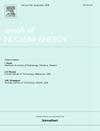Impact of U-10Mo HALEU Fuel Element Tolerances on the Massachusetts Institute of Technology Reactor safety and operational performance – Neutronics
IF 1.9
3区 工程技术
Q1 NUCLEAR SCIENCE & TECHNOLOGY
引用次数: 0
Abstract
The U.S. is coordinating efforts for the conversion of six U.S. high performance research reactors (USHPRR), including one critical assembly from highly enriched uranium (HEU) to low-enriched uranium (LEU). In order to continue the mission of these reactors, including the Massachusetts Institute of Technology Reactor (MITR), and achieve similar performance, high assay low-enriched uranium (HALEU) with a high-density metallic alloy of uranium with 10 wt% molybdenum (U-10Mo) is being considered. Following the preliminary design of the proposed MITR LEU fuel elements using the U-10Mo monolithic alloy, the impact of the fabrication specification was assessed. This work focuses on the analysis of select neutronics characteristics of the MITR LEU core as a function of the variation of the relevant fuel specification parameters (e.g., U-10Mo composition, fuel plate thickness, etc.). A separate article submitted to this journal addresses the impact on the thermal hydraulic performance. The analyses in these works are performed based on an all-LEU conversion management plan identified in previous work, in which only the proposed elements are utilized for achieving the conversion of MITR. The variations of two main neutronics characteristics are assessed as a function of the variability of the specification parameters resulting from the fabrication process: the MITR LEU core reactivity and the fuel cycle length. The main findings of this work show that the MITR core can meet the operational requirements during the LEU transition plan under the limiting fabrication parameter combinations considered. In addition, the analyses show that the dependency of the core neutronics characteristics on the specification parameters is highly linear within the specification tolerances. The rates of variation are reported in detail for each parameter and can serve as a powerful tool for future MITR fuel management in cases such as when HALEU supply is established that may allow additional cycle length or other operational benefits.
U-10Mo HALEU 燃料元件公差对麻省理工学院反应堆安全和运行性能的影响 - 中子学
美国正在协调将六座美国高性能研究反应堆(USHPRR)改造的工作,其中包括一个由高浓缩铀(HEU)改造为低浓缩铀(LEU)的关键组件。为了延续包括麻省理工学院反应堆(MITR)在内的这些反应堆的使命,并实现类似的性能,正在考虑采用含10 wt%钼(U-10Mo)的高密度金属合金铀的高含量低浓缩铀(HALEU)。在使用U-10Mo整体合金的拟议MITR低浓铀燃料元件的初步设计之后,评估了制造规范的影响。本文重点分析了MITR低浓铀堆芯的部分中子特性随相关燃料规格参数(如铀- 10mo成分、燃料板厚度等)变化的函数关系。提交给该杂志的另一篇文章讨论了对热工性能的影响。这些工作中的分析是基于先前工作中确定的全低浓铀转换管理计划进行的,其中只有建议的元素被用于实现MITR的转换。两个主要中子特性的变化被评估为由制造过程产生的规格参数变化的函数:MITR低浓铀堆芯反应性和燃料循环长度。本研究的主要结果表明,在考虑的极限制造参数组合下,MITR堆芯可以满足低浓铀过渡计划期间的运行要求。此外,分析表明,在规格公差范围内,堆芯中子特性与规格参数的关系呈高度线性关系。详细报告了每个参数的变化率,并且可以作为未来MITR燃料管理的强大工具,例如当建立低浓铀供应时,可能会增加周期长度或其他操作效益。
本文章由计算机程序翻译,如有差异,请以英文原文为准。
求助全文
约1分钟内获得全文
求助全文
来源期刊

Annals of Nuclear Energy
工程技术-核科学技术
CiteScore
4.30
自引率
21.10%
发文量
632
审稿时长
7.3 months
期刊介绍:
Annals of Nuclear Energy provides an international medium for the communication of original research, ideas and developments in all areas of the field of nuclear energy science and technology. Its scope embraces nuclear fuel reserves, fuel cycles and cost, materials, processing, system and component technology (fission only), design and optimization, direct conversion of nuclear energy sources, environmental control, reactor physics, heat transfer and fluid dynamics, structural analysis, fuel management, future developments, nuclear fuel and safety, nuclear aerosol, neutron physics, computer technology (both software and hardware), risk assessment, radioactive waste disposal and reactor thermal hydraulics. Papers submitted to Annals need to demonstrate a clear link to nuclear power generation/nuclear engineering. Papers which deal with pure nuclear physics, pure health physics, imaging, or attenuation and shielding properties of concretes and various geological materials are not within the scope of the journal. Also, papers that deal with policy or economics are not within the scope of the journal.
 求助内容:
求助内容: 应助结果提醒方式:
应助结果提醒方式:


